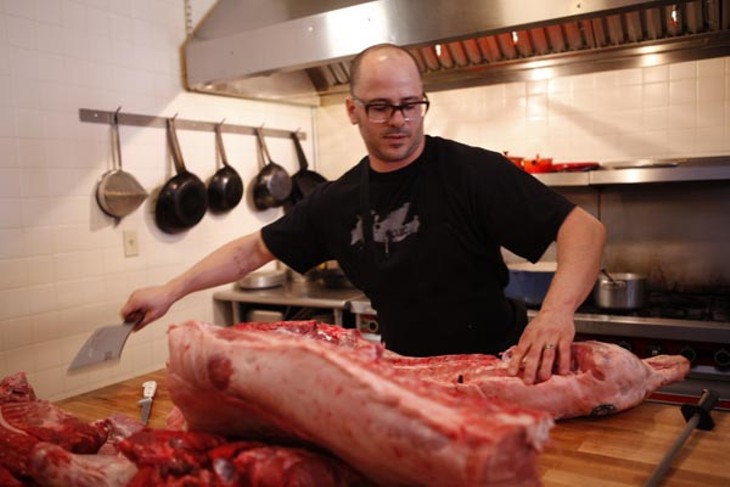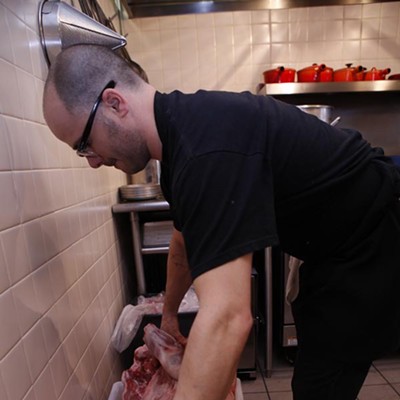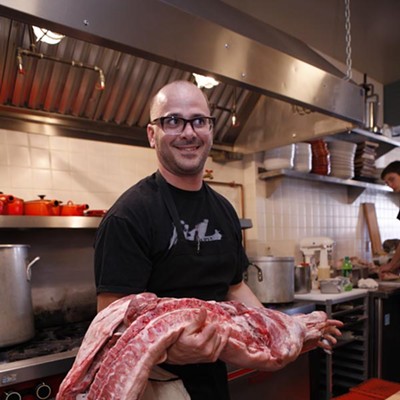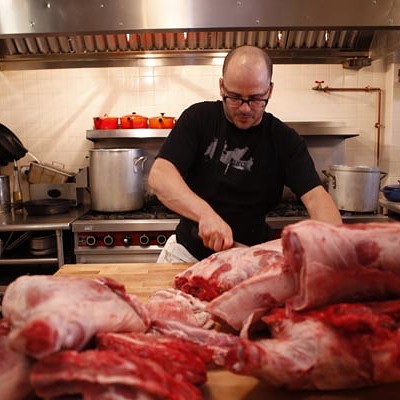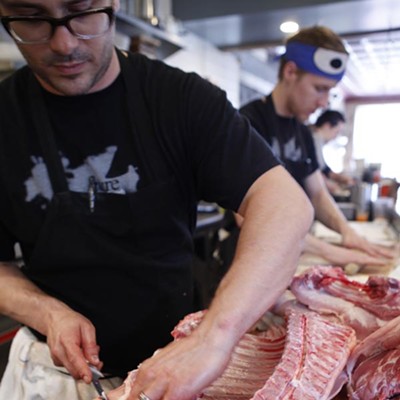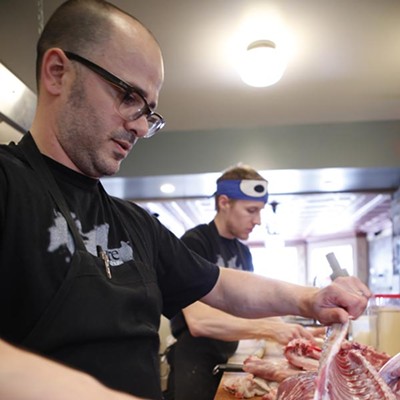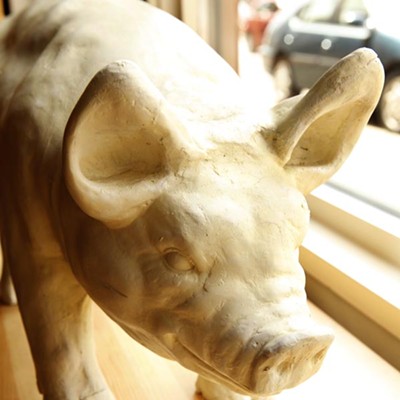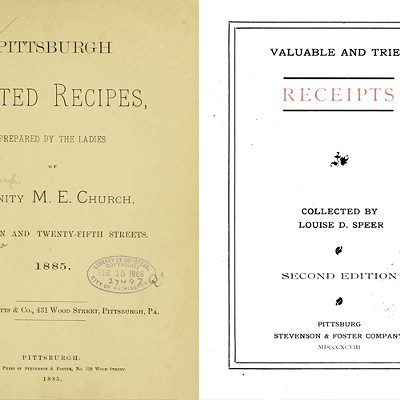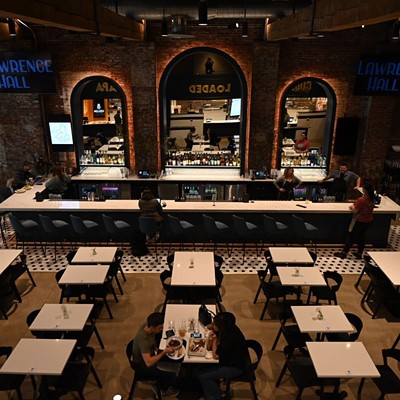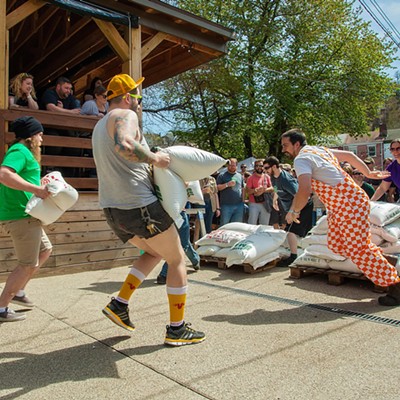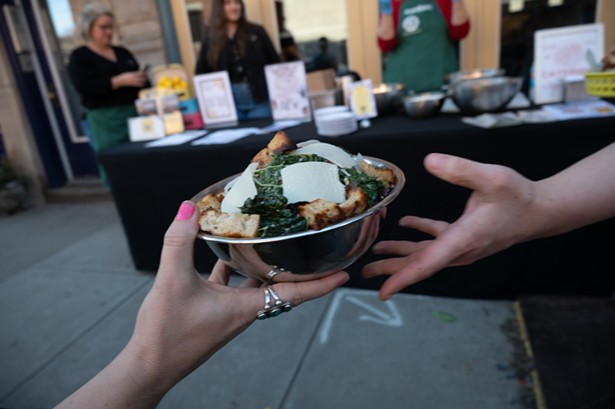When last we checked in with chef Justin Severino, he was providing a jaw-dropping array of meats, cheeses and tiny, particular salads on the charcuterie menu at Downtown's Elements. Severino grew up in Western Pennsylvania, learned to cook on the West Coast, and came back to Pittsburgh to make his mark on the local culinary scene, bringing with him a dedication to ethical farming practices and the humane treatment of animals which have become central to his approach to food. Interestingly, though, this hasn't led Severino to vegetarianism. Another of his passions is traditional foodways, and those certainly involve meat, which, in the days before refrigeration, was often smoked, salted or cured.
Hence the name of Severino's new restaurant in Lawrenceville. Actually, Cure's menu isn't primarily driven by cured meats, but by a loving attention to butchery, especially of pork. Cure's rustic-chic interior celebrates this delicious animal with a just-short-of-kitschy display of pig figurines, piggy banks, salt-and-pepper shakers and even a mounted wild boar head with tusks bared.
If the decor stopped shy of preciousness, the menu may have overstepped the line: It was a miniature cutting board with a torn piece of paper attached by a rubber band. But what it listed was so delightful we forgave its design. Cure offers a half-dozen "snacks," or starters; a half-dozen entrees; and just two "treats": a cheeseboard or chocolate soufflé cake. The offerings are seasonal, and the night we visited, they included a couple of extremely timely ingredients: ramps and, surprisingly, knotweed, which is pretty much only edible the moment it first sprouts.
We revisited the intense satisfaction we'd experienced at Elements with salumi, Cure's charcuterie platter. This exceeded our expectations with intensely rich duck speck; subtly satisfying lomo (essentially prosciutto-style pork loin); luscious, pate-like duck rillettes; smoky lamb pepperoni; and more. Nor did the board loaded with no fewer than seven forms of meat ever grow tiring or overwhelming: Each item was well balanced with the rest, and the selection as a whole offered choices savory, mild, decadent and in between. Our only real complaint was the scanty portion of toasts, which came spread with lardo (which is just what it sounds like, and tastes like an intense, slightly meaty, butter). That more or less forestalled their use with the other meats. While a baguette would be a bit much in the context of a "snack," we wished for a more plain bread or cracker to re-set our palates between bites of cured meat and pickled vegetables.
A snack of ramps also left us wishing for more bread after we inhaled the garlic bread dripping with melted taleggio almost instantly. Beneath the bread were three wilted ramps atop a smear of ramp puree, which concentrated the wonderfully vegetal, subtly garlicky flavor of what is rapidly becoming a calling card of local springtime cuisine, and a dollop of rich, syrupy aged balsamic. We loved how this dish gave a sophisticated presentation — and preparation — to a humble, heartily flavored food.
Despite the carnivorous theme of Cure, Severino is happy to give vegetables center stage, not only in a vegetarian item (risotto with local mushrooms), but also in a pair of dishes focused on pasta dumplings. While chestnut gnocchi and cavatelli were accompanied by meat, vegetable flavors predominated, and the gnocchi in particular showed just how a good chef can coax intense umami notes from leaves, fruits, gourds and grains. Earthy chestnut flavor roundly filled the mouth, while large chunks of guanciale (cured pork jowl) were cooked to a melting softness, and a simple butter-cheese sauce, spiked with garlic and rosemary, provided cohesion.
Pasta carbonara was prepared with sweet-pea ravioli, pancetta and a touch of chili in the traditional sauce of egg, pecorino romano cheese and butter. The sweetness of the peas and salty smokiness of the pancetta perfectly offset the luxurious sauce. But linguine with mussels and clams was served in an emerald-green rapini-pesto sauce that was much too salty. This was a shame, as the dish also featured bottarga — cured and dried fish roe — surely a flavorful component whose individual character was lost among the other ingredients.
Jason never doubted that he would order the entrée titled simply "Pork." This combined both tenderloin and rib roast with sauerkraut and lard-cooked potatoes, seasoning them with creamy Bernaise and violet mustard. The rib roast was extraordinarily succulent — several carved slices, no bone in sight — while the tenderloin had been seared for a bit of textural contrast. But it was the mustard that truly stood out, a smooth, dark spread with a hint of piquancy and floral topnotes that brought the subtlest touch of spring to a wintry dish.
The kitchen was not so sure with hanger steak au poivre. The meat was juicy and beautifully cooked but, sad to say, a bit tough, even when sliced thin. However, we will praise the inclusion, along with a little salad of cress and soft boiled pullet egg, of a mound of soubise, an onion preparation that cooks so slowly that it never caramelizes, but does become soft as noodles and almost buttery sweet.
Cure is a welcome addition to Pittsburgh's ever-expanding food scene. It satisfies the carnivore's appetite with connoisseurship, not only of meats, but of the accompaniments that make meat into a wonderful meal.
Editor's note: An earlier version of this story had an incorrect first name for chef Justin Severino.



